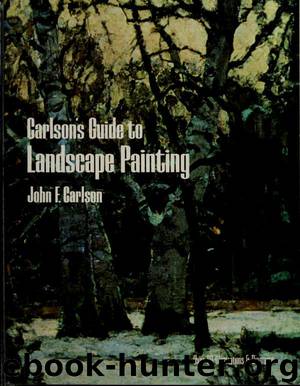Carlson's guide to landscape painting by Carlson John F

Author:Carlson, John F
Language: eng
Format: epub
Publisher: New York : Dover Publications
Published: 1973-08-31T04:00:00+00:00
Observe carefully that trees, as they recede into the atmosphere, never lose their identity as upright planes. A tree in the foreground is of positive color (a warm green, let us say). The same tree when viewed from a distant point might be a cool green or even a greenish-blue, depending entirely upon the distance and consequent number of curtains of atmosphere through which it is seen.
the structural angles, all for the sake of "getting the color," as though color could be obtained by reversing a physical truth. If the blue, for instance, of a given sky is painted with such abandon that the sky begins to assume the appearance of cavernous darks and granite ledges, where cavernous darks and granite ledges should not and could not exist, and this sky as a consequence looks "strong" enough to support a cavalry charge (while the poor land, lighter with its pale pinks and warm greens, looks transparent), the painter of such incongruity may be "getting the color" but he is certainly not painting a landscape. What I have called a landscape sense should help prevent such performances.
It has been seen that a flat mass of dark value represents the upright plane in the beginning of a landscape. Whatever local color this mass may possess, or whatever modulations may be necessary within the mass to give it form, these upright masses almost invariably get slightly lighter by degrees as they rise from the flat; and not only lighter, but cooler in tone. The darkest and warmest portions of these upright masses are usually near, but not at the ground. There also occurs on a tree a lateral or side-to-side transition of value and color, approaching the source of light.
To illustrate this idea let us assume that the abstract form of all trees combined would be a shape something akin to the elongated gas bag of a balloon. The light from the sky falling upon such a shape would result in an increasing darkening of its color as it leaves the lighted area on top. There would also be a lateral gradation of color and value from the side nearest the sun to the side farthest from it. This sounds absurdly simple, but I have found few students who felt this when painting a tree.
This big form is difficult to preserve, because by the time we have modelled the smaller forms upon the big and added the
necessary highlights and shadows, the chances are that we have overdone these so that our big form is cut up and spotty. These highlights and shadows belong there, but we may put too many brilliant highlights upon it; meaning that we may put lights upon the upright form that should possibly belong to the flat-lying plane. This passion for putting too many and too brilliant "lights" upon all the forms or planes is responsible for more good studies coming to grief than any other cause.
My whole energy is usually necessary to keep beginners from painting the entire tree with highlight value.
Download
This site does not store any files on its server. We only index and link to content provided by other sites. Please contact the content providers to delete copyright contents if any and email us, we'll remove relevant links or contents immediately.
The Husband's Secret by Liane Moriarty(2436)
Learn Drawing Quickly by Sharon Finmark(2417)
Drawing and Painting Birds by Tim Wootton(2338)
The Unlikely Pilgrimage of Harold Fry by Rachel Joyce(2137)
Classical Drawing Atelier by Juliette Aristides(1996)
One Drawing A Day by Veronica Lawlor(1720)
The Art of Creative Watercolor by Danielle Donaldson(1712)
Oil Painting For Dummies by Anita Marie Giddings & Sherry Stone Clifton(1658)
Hieronymus Bosch by Virginia Pitts Rembert(1577)
Elizabeth Is Missing by Emma Healey(1564)
Anywhere, Anytime Art: Crayon by Monika Forsberg(1521)
Special Subjects: Basic Color Theory by Patti Mollica(1514)
Post-Impressionism by Nathalia Brodskaya(1511)
Woman's Mysteries by Esther Harding(1460)
Memory's Wake by Fenech Selina(1399)
Fundamentals of Drawing by Barrington Barber(1260)
Landscape Painting in Pastel by Elizabeth Mowry(1210)
Acrylic Fusion by Dan Tranberg(1209)
Drawing by William Powell(1196)
